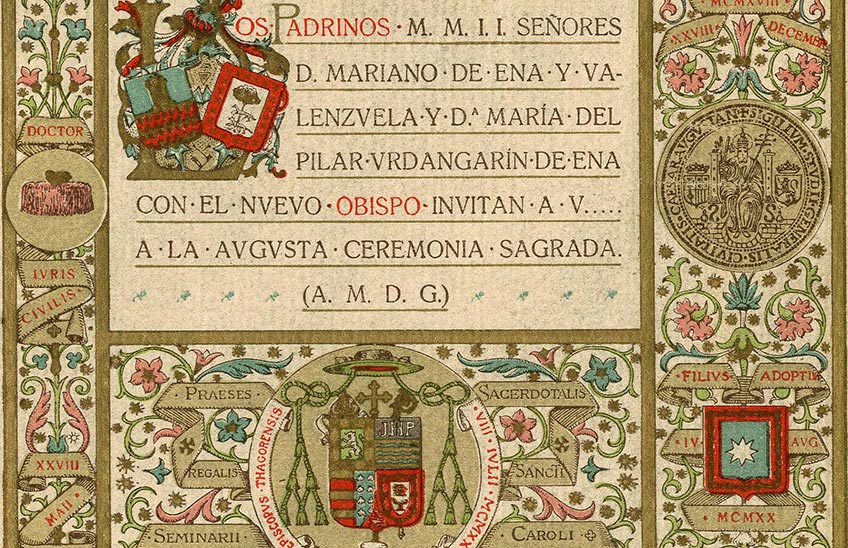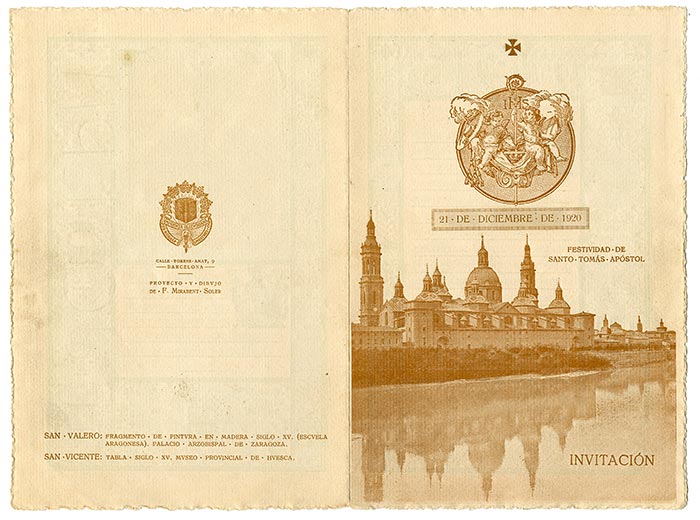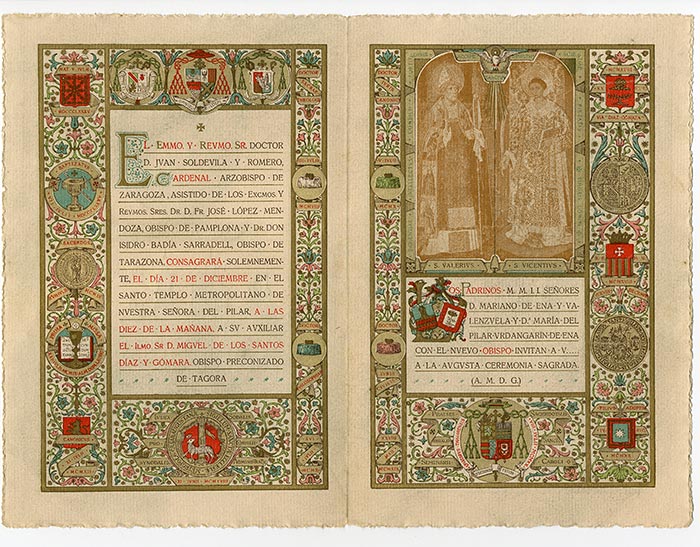Invitation for the episcopal ordination of Miguel de los Santos Díaz y Gómara (1920): the shaping of a curriculum A

PhotoCedit/Invitation details
A few weeks ago I learned of the invitation to the episcopal ordination of Don Miguel de los Santos Díaz y Gómara, as auxiliary bishop to Cardinal Soldevila, which took place in the Basilica of El Pilar in Zaragoza on 21 December 1920. The new bishop was endorsed by a A cursus honorum of programs of study civil and ecclesiastical , as well as by the social recognition of different institutions. The invitation is a faithful reflection of all this.
Don Miguel was born in Fitero in 1885 and died in Murcia in 1949. He was auxiliary bishop of Zaragoza (1920-1924), bishop of Burgo de Osma (1924-1935), bishop of Cartagena-Murcia (1935-1949) and apostolic administrator of Barcelona (1939-1942). His curriculum with four doctorates, programs of study civil and ecclesiastical in Spain and Italy, made him one of the great intellectual figures of the episcopate of his time.
design and printing
The printed invitation was designed with great care and perfection by Francesc Mirabent (1863-1941), who trained with his father José Mirabent Gatell (1831-1899), the best and most renowned decorator in Barcelona at the time, and was taught by the prestigious Luis Rigalt, Ramón de Manjarrés, Francisco Miquel Badía and Gerónimo Faraudo. He received a travel grant from the Diputació de Barcelona to perfect his programs of study in Paris and Antwerp. He won several prizes at exhibitions and competitions and the gold medal at the 1900 Paris Universal Exhibition exhibition . He specialised in the production of miniature scrolls and designs for liturgical vestments.
 Invitation unfolded on the outside
Invitation unfolded on the outside
If the designer of the invitation was the most prestigious in Barcelona, the printing house chosen was no less prestigious, as the commission fell to one of the most skilful and neatest establishments in the city, that of Josep Borrás Malibern (1880-1948), who after several experiences with different printing houses, in 1902 set up the "Imprenta Ezeviriana de Borrás y Mestres", a company that was successively expanded until it became, in 1921, "Imprenta Ezeviriana y bookshop Camí S. A.". A few years later, he devoted himself to writing some technical-pedagogical works on the art of printing.
The invitation
Preciousness is what characterises, from entrance, the print published in colour and in great detail. If we add to the formal content the data illustrations with their inscriptions, we find ourselves before a biography of the ordinand, who was then 35 years old and not wasted in terms of intellectual training and degree program ecclesiastical.
The print is in folio size, folded horizontally. The outside is in sepia and brown tones. The front side is illustrated with the repeated view of the Basilica del Pilar from the Ebro, but without the rear towers which, as is well known, were erected between 1949 and 1961. There is also a background with angels holding the bishop's hat, mitre and crosier, as well as the date 21 December, corresponding to the consecration and feast of St Thomas the Apostle. The reverse is cleaner with the stamp, the designer's and printer's data and the caption of the two photos of the saints' tablets on the inside of the invitation.
 Invitation unfolded on the inside
Invitation unfolded on the inside
The surprise arises when opening the card and finding the colour and countless objects and heraldic coats of arms that, like talking elements, reveal the programs of study and merits of Bishop Díaz y Gómara. The borders on the left and right show seals, liturgical objects and coats of arms. On the left, we find the heraldic emblem of Navarre with the date of Don Miguel's birth (5-VII-1885); a baptismal font with the date of his baptism (7-VII-1885), the seal of the Spanish high school in Rome, where he was ordained by Rafael Merry del Val, Cardinal Secretary of State (18-VII-1909); a missal and the Eucharist, alluding to his first mass celebrated in the Santa Casa de Loreto (21-VII-1909) and the coat of arms of the city of Saragossa in allusion to his taking possession of the canonry in El Pilar (11-VII-1912). The outer border on the right shows the coat of arms of the town of Fitero, where he was born and where the street where he was born was dedicated to him, a fact that is reflected in the date on the border of the heraldic emblem (20-IX-1918); the coat of arms of the University of Zaragoza, where he studied programs of study and was a professor; that of La Merced, for having been confessor to the nuns of that order (28-XII-1918); that of the University of Saragossa and that of the city of Estella, which honoured him with the degree scroll of adopted son (4-VIII-1920), for having been educated as a child in the Pious Schools of that town.
The interior ornaments are made up of four birettas, corresponding to his four doctorates in Theology (Saragossa, 3-VII-1908), Canon Law (Rome, 5-VII-1910), Philosophy (Rome, 16-VII-1910) and Civil Law (Madrid, 18-VII-1919).
The central body of the left side is occupied by the text of the invitation, with the coats of arms of the consecrators in the upper part: Cardinal Soldevila and bishops of Pamplona and Tarazona and that of the archbishopric of Saragossa. The date of June 11, 1918, when he was appointed synodal judge, also appears. The right side has three parts. In the upper part there is a reproduction of two Gothic panels of St. Valero and St. Vincent, bordered by the gifts of the Holy Spirit, which is also represented in the form of a dove. In the central area are the coats of arms of the godfathers of the ordination, Don Mariano de Ena y Valenzuela and Doña María Pilar Urdangarín. In the lower part we find the episcopal arms of the new bishop, with the date of his promotion (8-VII-1920), showing his condition of maximum manager of the seminar of San Carlos of the Aragonese capital.
To find out more
LLIN CHÁFER, A., "Miguel de los Santos Díaz Gómara", Biographical Dictionary of the Royal Academy of History, enquiry 26 October 2021
RÁFOLS, J. F., Diccionario Biográfico de Artistas de Cataluña desde la época romana hasta nuestros días, t. I y II, Barcelona, publishing house Millá, 1951 and 1953.
Home and People. Semanario Católico. Órgano de la Acción Social Diocesana, no. 439, Burgo de Osma, 8 November 1924.
bulletin Oficial Eclesiástico del Obispado de Cartagena. issue extraordinary dedicated to... Dr. D. Miguel de los Santos Díaz y Gómara on the XXV anniversary of his episcopal consecration, Murcia, 1945, 74 pp.
